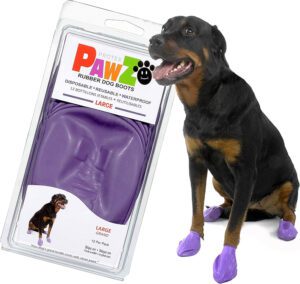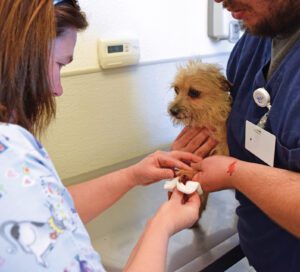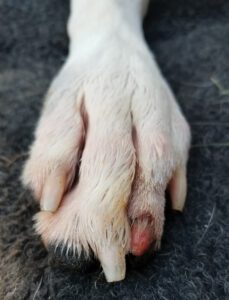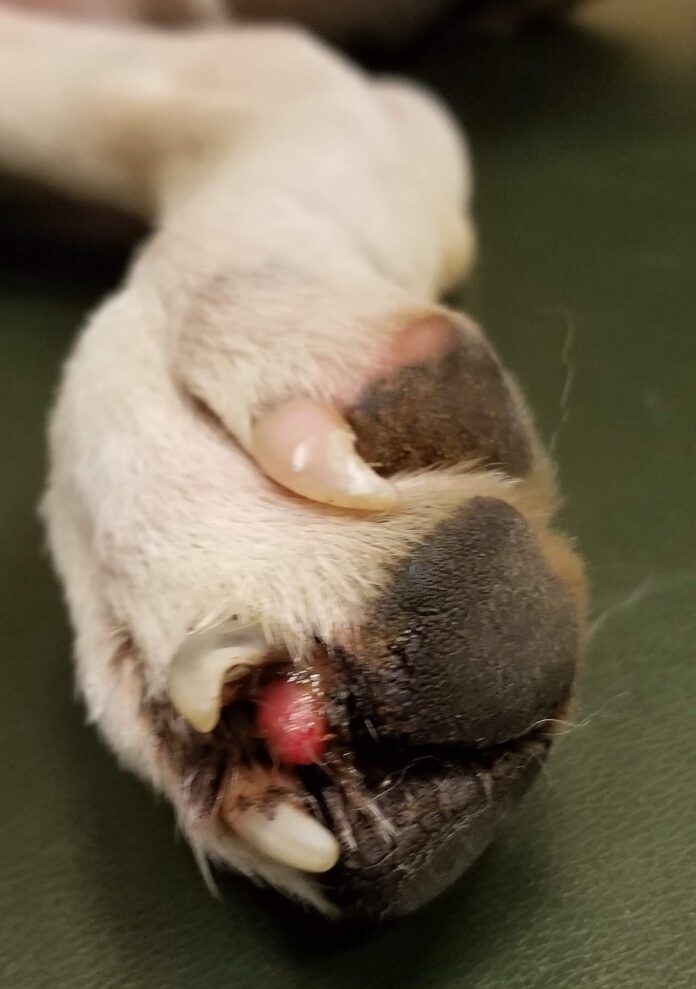Torn or split nails are a fairly common problem with dogs but can be easily addressed by either you or your veterinarian. Some torn or damaged claws are not easy to remove, or may be so painful for your dog that he requires sedation to properly remove the damaged claw. Seek veterinary care in these situations, or if you notice a foul odor or discharge from the nailbed, or if the affected toe appears red and swollen. These are signs of an infection and an antibiotic may need to be prescribed.
But if there are no signs of infection, and your dog will allow you to examine the damaged nail, you can treat the broken or split nail yourself. Be aware, however, that torn nails are very painful. Even the sweetest dog on earth may get a little snippy about having a torn claw touched.
Place an Elizabethan collar on your dog (a.k.a. a “cone”). You can also use a muzzle. This will keep you from being accidentally bitten as you take care of the broken nail.
How to Fix a Vertically Split Nail for a Dog
If the nail has been split vertically with the quick exposed and one side of the nail is freely movable, then you can try trimming away that side of the claw. Get as close to the base of the split as you can without damaging or cutting the quick.
If the nail is split or cracked vertically but both sides of the claw are firmly attached to the quick, then treatment is as follows: Trim the end of the claw as you normally would for routine nail trims. Then round the end of the claw and the edges of the crack with a nail file or, better yet, a Dremel tool. This will help to keep the claw from getting snagged and causing further damage.

Ideally, have your dog wear a protective boot on the affected paw for about a week until the claw starts to grow out past the split point. (My favorite products for this purpose are called Pawz; they are thin, lightweight, and well tolerated by most dogs, even ones that don’t like to wear boots. They are available online and in many major pet supply chain stores.)
Whatever you do, do not use superglue on a vertically split nail! When applied to a surface, superglue undergoes a chemical reaction that generates heat. If you apply superglue to a cracked nail, the heat it generates may burn the very sensitive quick.
Home Treatment for Broken Dog Nails

If your dog’s nail is bleeding, address that first. Apply a generous layer of styptic powder (often sold under the name “Kwik Stop”) to the torn nail. If you don’t have styptic powder, you can use flour or corn starch.
Applying a cool compress to the nail and toe for a few minutes will help slow the blood flow from the exposed nailbed. A Chinese herb called yunnan baiyao may also help stop the bleeding. Just open the capsule and apply the contents to the exposed nailbed.
Once the bleeding has stopped completely, you can address the torn nail with the following steps.
- Remove the damaged part of the nail. If the nail is almost completely torn off, you may be able to remove the damaged nail with just a quick pull using a pair of tweezers or your fingers. If it is loose but still somewhat attached, then you may need to trim off the damaged part using nail trimmers.
- Gently clean the affected toe and nail with a chlorhexidine-based disinfectant solution, such as Dermachlor (chlorhexidine gluconate 0.2%). You can also use dish soap and warm water. Be sure to rinse the paw and dry it well.
- Apply a bandage to the affected paw to protect the exposed nailbed as it heals. Place a non-stick pad (also known as a non-adhesive pad or Telfa pad) over the end of the affected toe. Wrap soft cotton cast padding or rolled gauze around the paw and over the non-stick pad to hold it in placeNext, you need to cover the padding or gauze with a couple layers of fabric self-adhesive wrap (such as Vetrap), but before you do this, unroll and then re-roll some of the wrap before you apply it. This removes the tension from the roll so that you don’t make the bandage too tight. You may apply a layer of first-aid adhesive tape at the top of the bandage to help hold it in place. Do not make the bandage tight! The goal is to simply protect the exposed nailbed.
- Replace the bandage once a day for the next three to five days. Keep the bandage clean and dry and replace the bandage immediately if it becomes wet or soiled. You can apply a layer of Press’n Seal plastic wrap to the bandage before your dog goes out in the rain or snow. Be sure to remove the plastic wrap after your dog comes back inside.
- Have your dog wear an Elizabethan or other recovery collar while the paw is bandaged to prevent him from chewing off the bandage. If your dog continues to lick his paw after the bandage is no longer necessary, he may need to wear the Elizabethan collar for a few additional days until the nailbed is no longer sensitive.

You can find the necessary bandage supplies, including fabric adhesive wrap, in the first aid section of pharmacies or grocery stores. The wrap and chlorhexidine cleansing solution can be found at most pet supply stores or through online pet supply retailers. It’s a good idea to have these supplies on hand so that you have them when the need arises. (See “12 Items to Include in Your DIY First-Aid Kit,” WDJ April 2022.)
How Long Does it Take for a Dog’s Broken Nail to Heal
A claw that has been torn will take several weeks to grow back. The new claw will likely appear normal but may be somewhat deformed. If your dog appears sensitive about walking on the affected paw, you may want to apply a protective boot when walking outside. Again, this is a situation where one of the Pawz lightweight rubber boots would be perfect.
Trimming your dog’s claws regularly can help minimize the risk of tearing a nail. Once a month is a typical routine, although some dogs may require trimming every two to three weeks.
If you notice that your dog’s claws seem brittle or if the claws are lifting off and separating from the nailbed on a regular basis, have your dog assessed by a veterinarian. Certain fungal and bacterial infections, autoimmune disorders, and endocrine diseases can cause abnormal growth of the claws or brittle nails.







Diana split her dew claw right up to her cuticle. I made the mistake of taking her to the vet. That experience started her anxiety about vet visits and Covid only made it worse when I couldn’t come with her. Now she is so fearful of the vet she must be sedated. I have switched to a fear-free vet and she is making improvements. But she is four now and I am afraid she will never improve to the point she can be handled without medication during her lifetime. I am going to start taking my dremel with me to the vet for a few quick trims before the sedation wears off.